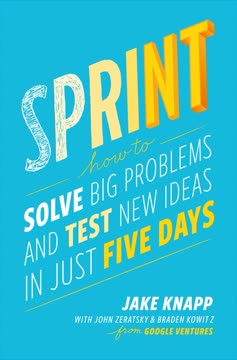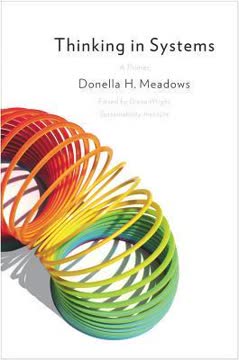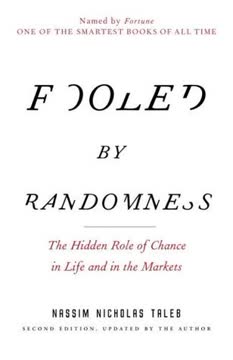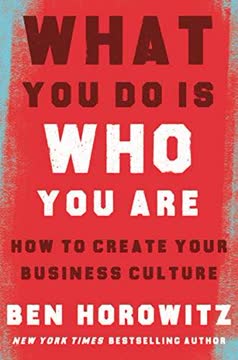نکات کلیدی
1. زندگی کامل را در آغوش بگیرید، نه زندگی آسان
چالشهای معنادار را انتخاب کنید. زندگی کامل، زندگیای است پر از دستاوردهای مهم و رشد شخصی. این امر نیازمند تلاش مداوم برای درک و بهبود جنبههای مختلف زندگی، از جمله خانواده، دوستیها و کار است. این انتخاب به تابآوری در برابر شکستها و تمایل به یادگیری از ناکامیها نیاز دارد.
تحمل را برای موفقیت توسعه دهید. دستیابی به اهداف معنادار اغلب شامل شکستها در مسیر است. با دیدن این شکستها به عنوان فرصتهای یادگیری، مانند یک دانشمند که یک آزمایش ناموفق را میبیند، میتوانید انگیزه خود را برای ادامه تلاش حفظ کنید. این دیدگاه به شما کمک میکند تا استقامت ذهنی لازم برای ادامه در چالشها را بسازید و در نهایت به اهداف خود برسید.
2. تفکر واضح کلید شناسایی و بهرهبرداری از فرصتهاست
آمادگی امکان شناسایی فرصتها را فراهم میکند. تفکر واضح به شما این امکان را میدهد که روابط علت و معلولی حاکم بر موقعیتهای مختلف را درک کنید. این درک عمیق به عنوان آمادگی عمل میکند و به شما کمک میکند تا فرصتهایی را شناسایی کنید که دیگران ممکن است از دست بدهند. با توسعه این مهارت، شانس خود را برای مواجهه و بهرهبرداری از موقعیتهای امیدوارکننده افزایش میدهید.
شانس خود را بسازید. به جای تکیه بر شانس، به طور فعال برای بهبود توانایی خود در تفکر واضح کار کنید. این شامل:
- تحلیل موقعیتها برای درک علل زیرین
- شناسایی فرصتهای بالقوه در سناریوهای مختلف
- توسعه برنامههایی برای بهرهبرداری از این فرصتها
- بهطور مداوم درک و رویکرد خود را اصلاح کنید
با تمرین مداوم تفکر واضح، خود را در موقعیتی قرار میدهید که فرصتها را ایجاد و بهرهبرداری کنید، به جای اینکه منتظر شانس باشید.
3. واقعیت ذاتاً ساده است، نه پیچیده
سادگی زیر بنای پیچیدگی است. در حالی که واقعیت ممکن است در سطح پیچیده به نظر برسد، اما تحت تأثیر تعداد نسبتاً کمی از اصول یا علل بنیادی قرار دارد. با تمرکز بر شناسایی این عناصر اصلی، میتوانید درک واضحتری از موقعیتهای به ظاهر پیچیده پیدا کنید.
علل ریشهای را جستجو کنید. برای کشف سادگی ذاتی در موقعیتهای پیچیده:
- به جزئیات سطحی نگاه نکنید
- بارها بپرسید "چرا" تا به علل بنیادی برسید
- عوامل مشترکی که بر جنبههای مختلف وضعیت تأثیر میگذارند را شناسایی کنید
- نقشههای منطقی برای تجسم روابط بین عناصر ایجاد کنید
- فرضیات که ممکن است سادگی زیرین را پنهان کند، به چالش بکشید
با اتخاذ این ذهنیت، میتوانید به طور مؤثرتری مشکلات پیچیده را در زمینههای شخصی و حرفهای تحلیل و حل کنید.
4. تعارضات با به چالش کشیدن فرضیات قابل حذف هستند
تعارضات را به عنوان معماهای قابل حل بازتعریف کنید. به جای دیدن تعارضات به عنوان مسائل ذاتی و غیرقابل حل، به آنها به عنوان چالشهایی که باید با شناسایی و به چالش کشیدن فرضیات زیرین غلبه کرد، نزدیک شوید. این تغییر در دیدگاه امکانات جدیدی برای حل و فصل باز میکند.
روش سیستماتیک برای حل تعارض:
- تعارض را به وضوح تعریف کنید
- فرضیات زیرین را در هر دو طرف شناسایی کنید
- هر فرضیه را مورد سوال قرار دهید و به دنبال آنهایی باشید که ممکن است نادرست یا غیرضروری باشند
- دیدگاهها یا رویکردهای جایگزینی که این فرضیات را به چالش میکشند، بررسی کنید
- راهحلهایی توسعه دهید که به مسائل اصلی بدون تکیه بر فرضیات نادرست بپردازند
با به کارگیری این روش، تعارضات به ظاهر غیرقابل حل اغلب میتوانند به شیوههایی حل شوند که به نفع همه طرفهای درگیر باشد.
5. در تمام روابط به دنبال راهحلهای برد-برد باشید
به امکان هماهنگی ایمان داشته باشید. به هر رابطه با این باور نزدیک شوید که یک راهحل متقابل سودمند وجود دارد، حتی اگر بلافاصله قابل مشاهده نباشد. این ذهنیت امکانات خلاقانه را باز میکند و پایداری در یافتن راهحلها را تشویق میکند.
مراحل برای یافتن راهحلهای برد-برد:
- نیازها و منافع اصلی هر طرف را شناسایی کنید
- به دنبال اهداف مشترک بزرگتری باشید که منافع فردی را در بر بگیرد
- راهحلهایی که به این اهداف مشترک میپردازند، ابداع کنید
- بر گسترش منابع یا ایجاد ارزش جدید تمرکز کنید، نه تقسیم منابع موجود
- آماده باشید تا رویکردها یا فرضیات سنتی را به چالش بکشید
- در طول فرآیند به طور باز و همکاری ارتباط برقرار کنید
با جستجوی مداوم نتایج برد-برد، میتوانید روابط قویتر و هماهنگتری در زمینههای شخصی و حرفهای بسازید.
6. هرگز نگویید "من میدانم" - همیشه سوال کنید و بهبود یابید
بهبود مستمر را در آغوش بگیرید. از دام این فکر که کاملاً یک وضعیت را درک کردهاید، حتی زمانی که به موفقیت رسیدهاید، دوری کنید. همیشه به دنبال راههایی برای به چالش کشیدن فرضیات خود و بهبود درک و نتایج خود باشید.
استراتژیهایی برای رشد مداوم:
- نتایج غیرمنتظره، چه مثبت و چه منفی را تحلیل کنید
- فرضیات، به ویژه آنهایی که مدت طولانی وجود داشتهاند، را به چالش بکشید
- پیامدهای تغییرات و اطلاعات جدید را بررسی کنید
- به دنبال فرصتها در موقعیتها یا زمینههای جدید باشید
- دیدگاهها و ایدههای متنوع را تشویق کنید
- اهداف روزافزون و جاهطلبانهتری تعیین کنید تا مرزها را فشار دهید
با حفظ یک ذهنیت یادگیری، میتوانید به رشد و دستیابی فراتر از انتظارات اولیه خود ادامه دهید.
7. احساس، شهود و منطق پایههای تفکر واضح را تشکیل میدهند
تمام جنبههای تفکر را ادغام کنید. تفکر واضح تنها به منطق سرد مربوط نمیشود؛ بلکه نیازمند تعادل احساس، شهود و استدلال منطقی است. احساسات انگیزه را فراهم میکنند و نقاط مهم را برجسته میکنند، شهود بینشها و ارتباطات سریع را ارائه میدهد، در حالی که منطق به تأیید و اصلاح این بینشها کمک میکند.
توسعه تفکر واضح:
- واکنشهای احساسی خود را شناسایی و درک کنید
- به شهود خود در زمینههای تخصصی اعتماد کنید و آن را پرورش دهید
- از منطق برای تأیید و گسترش بینشهای شهودی استفاده کنید
- تمرین کنید که هر سه عنصر را در تصمیمگیری ادغام کنید
- درک کنید که تقویت یک جنبه اغلب به تقویت دیگران نیز کمک میکند
با هماهنگ کردن این سه عنصر، میتوانید فرآیندهای تفکر جامعتر و مؤثرتری را توسعه دهید.
8. انسانها ذاتاً خوب هستند - از سرزنش دوری کنید و به دنبال درک باشید
فرضیات منفی درباره انسانها را به چالش بکشید. فرهنگ ما اغلب ما را تشویق میکند که بدترین فرضیات را درباره دیگران، به ویژه در تعارضات، داشته باشیم. با رد این تمایل به طور آگاهانه و تلاش برای درک دیدگاههای دیگران، میتوانیم راهحلهای مؤثرتری پیدا کنیم و روابط بهتری بسازیم.
استراتژیهایی برای دوری از سرزنش:
- تعصبات و تأثیرات فرهنگی خود را شناسایی کنید
- به دنبال علل سیستمی یا موقعیتی باشید نه نقصهای شخصی
- به دنبال درک انگیزهها و محدودیتهای دیگران باشید
- بر یافتن راهحلها تمرکز کنید نه انتساب سرزنش
- همدلی و درک دیدگاهها را تمرین کنید
با اتخاذ یک دیدگاه مثبتتر درباره طبیعت انسانی، میتوانید به طور سازنده و همکاری به تعارضات و چالشها نزدیک شوید.
9. تمرین تفکر واضح برای توسعه شهود و دستیابی به موفقیت
تفکر واضح را به عنوان یک عادت پرورش دهید. به کارگیری مداوم اصول تفکر واضح در موقعیتهای مختلف به توسعه شهود و مهارتهای حل مسئله کمک میکند. با گذشت زمان، این تمرین میتواند به بینشها و راهحلهای به ظاهر بیزحمت منجر شود.
مراحل برای توسعه تفکر واضح:
- به طور منظم فرضیات و باورها را مورد سوال قرار دهید
- روابط علت و معلولی را در موقعیتهای مختلف تحلیل کنید
- به دنبال سادگی زیرین در مشکلات پیچیده باشید
- در تعارضات به دنبال راهحلهای برد-برد باشید
- به طور مداوم به دنبال بهبود و اصلاح درک خود باشید
- اصول تفکر واضح را در زمینههای شخصی و حرفهای به کار ببرید
با تبدیل تفکر واضح به یک عادت، میتوانید توانایی خود را در شناسایی فرصتها، حل مشکلات و دستیابی به موفقیت در تمام زمینههای زندگی افزایش دهید.
آخرین بهروزرسانی::
FAQ
What's "The Choice" by Eliyahu M. Goldratt about?
- Exploration of Clear Thinking: "The Choice" is about applying clear thinking to both personal and professional life to achieve a full life. Goldratt emphasizes the importance of understanding cause-and-effect relationships.
- Inherent Simplicity: The book introduces the concept of Inherent Simplicity, suggesting that reality is not as complex as it seems and can be understood through simple, logical analysis.
- Practical Philosophy: It combines business strategies with a life philosophy, encouraging readers to apply scientific thinking to everyday problems.
- Dialogue Format: The book is structured as a dialogue between Goldratt and his daughter, Efrat, making complex ideas more accessible and relatable.
Why should I read "The Choice" by Eliyahu M. Goldratt?
- Improved Problem-Solving: The book offers tools and perspectives to enhance problem-solving skills by understanding the root causes of issues.
- Personal and Professional Growth: It provides insights into achieving a full life by balancing personal aspirations with professional responsibilities.
- Unique Approach: Goldratt's method of applying scientific thinking to social sciences offers a fresh perspective on handling conflicts and making decisions.
- Engaging Format: The dialogue between Goldratt and his daughter makes the book engaging and easy to follow, even when discussing complex concepts.
What are the key takeaways of "The Choice" by Eliyahu M. Goldratt?
- Inherent Simplicity: Reality is simpler than it appears, and understanding it requires identifying the few root causes that govern complex systems.
- Conflict Resolution: Conflicts can be resolved by challenging underlying assumptions, leading to win-win solutions.
- Continuous Improvement: Never settle for diminishing returns; always seek further improvements, even in situations that seem optimal.
- Freedom of Choice: Individuals have the freedom to choose how they perceive and react to reality, which can lead to significant personal and professional growth.
How does Eliyahu M. Goldratt define "Inherent Simplicity"?
- Few Root Causes: Inherent Simplicity suggests that any complex system is governed by a few root causes, making it simpler to understand and manage.
- Convergence of Causes: As one dives deeper into understanding a system, causes converge, revealing the simplicity beneath apparent complexity.
- Application to Reality: This concept applies to all aspects of reality, including human behavior and organizational dynamics.
- Foundation for Clear Thinking: Accepting Inherent Simplicity is crucial for thinking clearly and effectively solving problems.
What is the "Freedom of Choice" concept in "The Choice"?
- Perception of Reality: Freedom of Choice refers to the ability to choose how one perceives and reacts to reality, impacting personal and professional outcomes.
- Learning from Failures: It involves viewing failures as opportunities to learn and improve, rather than as setbacks.
- Proactive Approach: Encourages taking responsibility for one's life and decisions, rather than blaming circumstances or others.
- Empowerment: By exercising this freedom, individuals can create more opportunities and achieve a fuller life.
How does "The Choice" address conflict resolution?
- Challenge Assumptions: Goldratt suggests that conflicts arise from underlying assumptions that can be challenged and changed.
- Win-Win Solutions: By removing false assumptions, conflicts can be resolved in a way that benefits all parties involved.
- Avoiding Compromise: Instead of settling for compromises, the book advocates for finding solutions that eliminate the conflict entirely.
- Practical Examples: The book provides real-world examples of how this approach can be applied in both personal and professional settings.
What are the best quotes from "The Choice" and what do they mean?
- "Reality is built in wonderful simplicity." This quote emphasizes the idea that beneath the complexity of reality lies a simple structure that can be understood through logical analysis.
- "The more complicated the situation seems to be, the simpler the solution must be." Goldratt suggests that complex problems often have simple solutions, which can be found by identifying the root causes.
- "Freedom of choice is the choice to invest in overcoming these obstacles." This highlights the power of personal agency in choosing to address and overcome challenges.
- "Every person is born with tremendous brainpower." Goldratt believes in the potential of every individual to think clearly and achieve a full life.
How does "The Choice" suggest one can improve their thinking skills?
- Practice Clear Thinking: Regularly practice identifying cause-and-effect relationships in everyday situations to improve clarity of thought.
- Avoid Tautologies: Be wary of circular logic and ensure that causes are substantiated by multiple effects.
- Challenge Perceptions: Continuously question and challenge your perceptions of reality to uncover simpler truths.
- Embrace Inherent Simplicity: Accept the concept of Inherent Simplicity to guide your thinking and problem-solving processes.
What role does intuition play in "The Choice"?
- Intuition and Emotion: Intuition is driven by emotion and is essential for generating hypotheses and understanding complex situations.
- Fuel for Logic: Intuition provides the initial connections that logic then builds upon to create a clear understanding of reality.
- Developing Intuition: By practicing clear thinking and engaging deeply with areas of interest, one can strengthen their intuition.
- Three-Legged Stool: Goldratt describes human understanding as a three-legged stool supported by emotion, intuition, and logic.
How does "The Choice" relate to Goldratt's Theory of Constraints?
- Application of TOC: The book applies the principles of the Theory of Constraints (TOC) to personal and professional life, emphasizing the identification and removal of constraints.
- Focus on Root Causes: Like TOC, "The Choice" focuses on identifying and addressing the few root causes that limit performance.
- Systemic Thinking: Encourages viewing problems as part of a larger system, where changes in one area can have significant impacts elsewhere.
- Continuous Improvement: Both TOC and "The Choice" advocate for ongoing improvement and the pursuit of breakthroughs.
What examples does "The Choice" provide to illustrate its concepts?
- BigBrand Case Study: The book uses the example of a large apparel company to demonstrate how identifying root causes can lead to significant improvements.
- Retailer Solution: Goldratt discusses his approach to improving operations in large retail chains, highlighting the simplicity of effective solutions.
- Personal Dialogues: The dialogue between Goldratt and his daughter provides relatable examples of applying these concepts to everyday life.
- Real-World Applications: Various reports and case studies throughout the book illustrate the practical application of Goldratt's ideas.
How can "The Choice" help in achieving a full life?
- Identifying Opportunities: By thinking clearly, individuals can better recognize and create opportunities for personal and professional growth.
- Overcoming Failures: The book provides strategies for learning from failures and using them as stepping stones to success.
- Enhancing Collaboration: Understanding and resolving conflicts can lead to more harmonious relationships and effective collaboration.
- Empowerment and Responsibility: Encourages taking control of one's life by making informed choices and taking responsibility for outcomes.
نقد و بررسی
کتاب انتخاب عمدتاً نقدهای مثبتی دریافت کرده و به خاطر بینشهایش در مورد فرآیندهای تفکر گلدرت و کاربردهای نظریه محدودیتها مورد ستایش قرار گرفته است. خوانندگان از قالب گفتوگو بین گلدرت و دخترش قدردانی میکنند که مفاهیم پیچیده را قابل دسترستر میسازد. این کتاب به بررسی موانع تفکر واضح پرداخته و استراتژیهایی برای حل مسئله در کسبوکار و زندگی ارائه میدهد. برخی منتقدان آن را کمتر جذاب از آثار داستانی گلدرت میدانند، در حالی که دیگران آن را عمیق و تغییر دهنده زندگی میانگارند. بسیاری توصیه میکنند که ابتدا کتابهای دیگر گلدرت خوانده شود تا درک بهتری از عمیقتر شدن فلسفه او در انتخاب حاصل گردد.
Similar Books



















